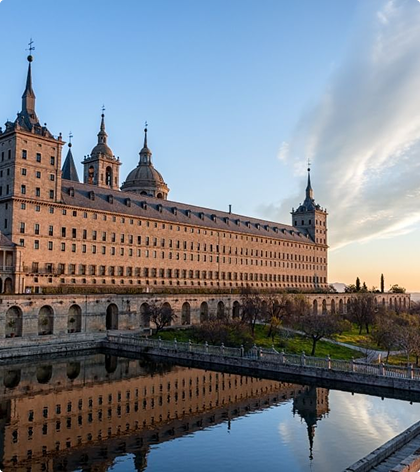Discover El Escorial: History, Heritage and Nature just a stone's throw from Madrid
Just an hour away from the bustling centre of the capital city lies San Lorenzo de El Escorial. A monumental and natural enclave that holds within its walls centuries of history. Considered by many as the eighth wonder of the world the El Escorial Monastery is a must-see for those who wish to explore one of the most important symbols of the Spanish Golden Age. Declared World Heritage by UNESCO. This architectural complex encapsulates the spirituality, politics and culture of a unique era.

The origin of an architectural jewel
King Philip II ordered the construction of the Monastery of San Lorenzo de El Escorial in the mid-16th century as a royal pantheon for his parents, Charles I and Isabella of Portugal, and to commemorate their victory in the Battle of Saint Quentin, fought on 10 August 1557, the feast of Saint Lawrence. Work began in 1562 and was completed in 1584, although the church was not consecrated until 1595.
The design was the work of Juan Bautista de Toledo and later continued by Juan de Herrera, whose sober, geometric style gave rise to what is known today as Herreraesque architecture. The complex was conceived as a place of spiritual retreat, study and prayer, and therefore includes a basilica, palace, monastery, seminary and a monumental library.
An essential visit to the Monastery
The El Escorial Monastery The dimensions are surprising: 207 metres long by 161 metres wide, with a 15 cloisters, 16 courtyards, more than 1,000 doors and more than 2,500 windows. Among its most notable spaces are:
- The Basilicawith a Greek cross plan and frescoes by Luca Giordano.
- The Royal Librarywhich houses thousands of manuscripts and ancient books, decorated with a vault painted by Pellegrino. Tibaldi.
- The PantheonsThe most important of these is that of the Kings, with marble and jasper that evoke the grandeur of the Habsburgs.
- The King's HouseThe austere and simple church, where Philip II spent his last days.
- The Battle Roomwith frescoes celebrating the military victories of the Spanish monarchy.
- The Palaces of the Habsburgs and the Bourbonswhere you can appreciate both the sobriety of the Habsburgs and the opulence of the Bourbons.
In addition, it is worth visiting the Museum of Painting the Museum of Architecture the Courtyard of the Kings and the Chapter Rooms.
Walks and sights in the surrounding area
Once the visit is over, we recommend a stroll through The Blacksmith's Shop. The extensive forest that inspired the monarch to build his monumental project here. Don't miss the Chair of Philip II This is a viewpoint carved into the rock from where the king is said to have supervised the monastery's works. The views of the complex from this point are unbeatable.
What to see in the municipality of El Escorial
Although they are often confused, El Escorial y San Lorenzo de El Escorial are different areas of the same municipality. The monastery is located in San Lorenzo, while El Escorial has several points of interest:
- La Casita del Príncipea neoclassical pleasure villa designed by Juan de Villanueva.
- The Church of San BernabéIt has a Herrerian style and an altarpiece presided over by a canvas by Juan Gómez.
- The Monastery of PrestadoThe building was the temporary residence of Philip II during the construction of the complex.
- The House MiñanaThe building is an example of 19th century neo-Mudéjar town planning.
- La Fresneda o La GranjillaThe property is a former pleasure estate with ponds, orchards and woodland.
La Herrería Forest which surrounds the monumental complex, is a protected area (SPA) within the Natura 2000 Network ideal for quiet walks in the middle of nature.
Where to eat in San Lorenzo de El Escorial
The surroundings of El Escorial also stand out for its gastronomy. Some of the most outstanding restaurants are:
- MontiaThe Michelin-starred restaurant specialises in seasonal cuisine.
- Charolaisfamous for its cocido madrileño stew in a rustic and traditional setting.
- Paco Pastelrenowned for its pastries and traditional daily menu.
- Cava Altaoffering Spanish cuisine with a creative twist.
- Vesta Tavernwith a menu based on local products and intense flavours, such as hake confit or entrecote from Ávila.
A perfect getaway from Gran Hotel Inglés
If you are staying at Gran Hotel Inglés, one of the most emblematic hotels in the capital, visiting El Escorial is an ideal plan for a cultural and natural day trip.
From this historic hotel in the centre of Madrid, you can conveniently organise your visit thanks to its excellent location and personalised concierge service.
After a day exploring this impressive legacy of the Spanish Renaissance, there is nothing better than returning to the comfort of this luxury hotel in Madrid, enjoying its spa, its exquisite gastronomy or relaxing in one of its impressive rooms.
A perfect balance between history, nature and sophistication! Make your reservation and live Madrid with the most complete experience!

